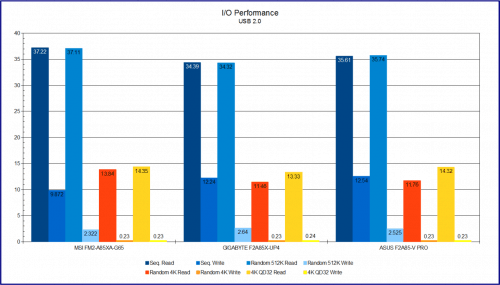Extreme Graphical Performance (Battlefield 3)
These kinds of test are often used a measurement stick with modified settings to focus on one aspect. I want to know the same thing you want to know: Ccan an AMD APU play BF3 at a reasonable frame rate. The only thing you need to know here is I forced the shared memory to 1 GB to prevent graphical tearing. I tested with Battlefield set to High settings, the chosen default.
This time the MSI FM2-A85XA-G65 falls behind the other two with the GIGABYTE GA-F2A85X-UP4 taking a slight lead in average FPS. I repeated this test on several 64-man servers on different levels and chose the best performance figures to use. The performance is virtually the same when you take into account play variance.
Now let’s check out how the hardware stacks up on the IO side of the equation.
SATA 6 Gbps I/O Performance (CrystalDiskMark 3.0.1 and ATTO Disk Benchmark)
My testing system now includes a new Western Digital VelociRaptor 1TB 10K RPM hard drive. This should allow the SATA control to perform much better in these tests as it is limted by the drive’s speed. It is also something we believe people would consider as a configuration for their own system by consolidating their storage and OS drive into one.
First let me say these new hard drives are loud but very awesome. AMD needs to work on their SATA drivers as I experience sporadic behavior with dips in performance on all three motherboards in various tests. There is no pattern and affects every board which is why it is likely the driver and not the motherboards.
USB 2.0 I/O Performance (CrystalDiskMark 3.0.1)
Now we will look back to USB 2.0 performance as it is still the most used interface on the PC market. USB 2.0 is still limited in its upper limits and I am still restricted by the performance of the device used in my tests. We will address this testing weakness in future reviews.
These results also have sporadic drops of 2 to 3 MB/s in data throughput; however, it only seems to affect the MSI FM2-A85XA-G65 and GIGABYTE GA-F2A85X-UP4. The ASUS F2A85-V PRO seems to maintain comparatively consistent performance levels for USB 2.0.
USB 3.0 I/O Performance (CrystalDiskMark 3.0.1)
Moving on to the next generation in USB with the 3.0 standards. Once again use of the WD VelociRaptor 1TB 10K RPM hard drive is leveraged. As we now have a baseline for comparison of the drives performance from the SATA testing, we can also account for possible overhead performance loss. To ensure consistency I tested all three boards with ports on the front panel which directly link to the AMD FCH native controller.
The MSI consistently takes the lead in these tests. The GIGABYTE takes a very noticeable drop during sequential read/write testing even when compared to just the ASUS. I retested these results with different ports, but could never get performance up to the same range as the other boards. GIGABYTE boards have done this before, but the issue is often corrected by the next AMD controller update. Hopefully this will be the case here as well.
Audio Performance (RightMark Audio Analyzer 6.2.3)
The audio test as always is done at 24-bit at 48 kHz with a crossover linking the Mic input to the audio output. Audio performance is often overlooked as people usually suggest getting a dedicated sound card. A dedicated sound card is a luxury few make room in their budget for, so this is something I want to working well out of the box. All three motherboards are using the same Realtek ALC892 codec.
Although all the boards use the same Realtek ALC892, implementation is key. The GIGABYTE has the best showing overall but general performance is rated to the same as the ASUS PRO. The GIGABYTE still has the best dynamic range and noise reduction though. The MSI turns in an average performance for an on-board audio system. It goes to show that the components are just as important as the implementation and if you have to have the best audio, then the GIGABYTE would be your best choice in this round up.
Power Consumption
To avoid any possible advantages I switched all boards back to their default Standard power schemes and restored all power management options to default. Keep in mind all three FM2 motherboards can be switched to a power saving mode that further reduces power consumption beyond my results. Lets look into if the overly aggressive power management systems on the GIGABYTE UP4 and ASUS PRO are worth their metal.
The MSI FM2 G65 and GIGABYTE FM2 UP4 have very similar power consumption figures. The UP4 comes in with the lowest idle power use and the MSI has the lowest maximum. The ASUS FM2 PRO falls in the middle at idle, but burns an extra 32 watts at full load. It seems to be related to the Fan Xpert 2, which I forgot to disable, since it was a sudden spike in power after several minutes at full load. The voltage increase to the fans to regulate heat increased the power draw.
I thought about disabling the software and retesting, but Fan Xpert 2 is a feature of the board I expect many to use. Disabling the software does bring the ASUS maximum power draw at full load down to 135.2 watts. We did expect the ASUS board to be more power hungry due to the extra components on board compared to the other boards. Burning a little more power for the Fan Xpert 2 functionality does result in CPU, GPU, and case temperatures coming down an average of 3°C, which can increase component life long term.
Now that all the testing is out of the way, it’s time to give you our final thoughts on each board and let you know which board is our pick (if possible).







